
HOME
INTRO
SYMBOLS
ALMANAC
ECONOMY
GEOGRAPHY
STATE MAPS
PEOPLE
FORUM
NEWS
COOL SCHOOLS
STATE QUIZ
STATE LINKS
BOOK STORE
MARKETPLACE
NETSTATE.STORE
NETSTATE.MALL
GUESTBOOK
CONTACT US


Dbl click any word in
document for definition.
Texas State Plant
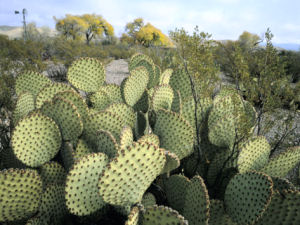
Texas State Plant: Prickly Pear Cactus
Photographs, prints, posters
There are about a dozen, or so, species of prickly pear cactus found in the deserts of North America.
All of these cacti (Genus Opuntia) maintain branches and stems in the form of large, flat pads.
These pads are ideal for water storage in dry, desert areas, found in Southwestern Texas; the Chihuahuan Desert and the Tamaulipan mezquital.
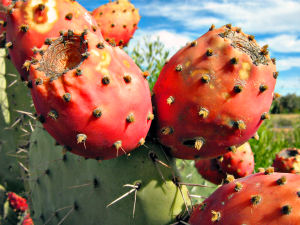
Texas State Plant: Prickly Pear Cactus Tunas
Photographs, prints, posters
The deep red fruit of the prickly pear cactus is referred to as tuna and most are edible. The broad stems, or pads, (nopales) are also edible.
On January 23, 1995 House Concurrent Resolution No. 44 was filed. It proposed that the prickly pear cactus be named the official state plant of Texas. It was referred to the House State, Federal and International Relations Committee.
The prickly pear cactus was promoted for its ruggedness, its beauty, and its versatility.
"Rugged, versatile, and beautiful, the prickly pear cactus has made numerous contributions to the landscape, cuisine, and character of the Lone Star State, and its unusual status as both a vegetable and a fruit make it singularly qualified to represent the indomitable and unique Texas spirit as an official state symbol"
("House Concurrent Resolution No. 44")
H.C.R. No. 44
HOUSE CONCURRENT RESOLUTION
WHEREAS, The State of Texas has traditionally recognized certain terrestrial forms indigenous to the state as official state symbols; and
WHEREAS, The bluebonnet, the pecan tree, and the mockingbird are examples of some natural specimens that serve to symbolize the rich diversity of the plains, forests, skies, and mountains of our vast state; and
WHEREAS, In keeping with this custom, the designation of the prickly pear cactus as the official state plant will provide suitable recognition for this hearty and beautiful denizen of the Texas landscape; and
WHEREAS, A native of the American Southwest and the Sonoran Desert region of Mexico, the prickly pear cactus provided nourishment to the earliest inhabitants of those regions, and both the sweet, fleshy fruit and the broad, flat stems were incorporated into tasty dishes; and
WHEREAS, Tunas, the prickly pear fruit, and nopales, which are made from the stem, have since become staples of the Mexican diet, and their growing popularity in Lone Star cuisine can be attributed to Texans' appreciation for unusual and distinctive foods; and
WHEREAS, In recent years, the prickly pear cactus has been successfully exported and naturalized to tropical areas around the world, and it has proven to be a popular landscape choice for all who want to have a little bit of Texas in their own backyards; and
WHEREAS, This adaptable plant can survive under many different environmental conditions, and thus can be found from the hill country of Central Texas to the windswept plateaus and arid mountains of West Texas; because it thrives in a harsh climate that few plants can bear, the prickly pear cactus is often grown as forage for cattle and has had a tremendous positive impact on the vital Texas cattle industry; and
WHEREAS, Rugged, versatile, and uniquely beautiful, the prickly pear cactus has made numerous contributions to the landscape, cuisine, and character of the Lone Star State, and thus it is singularly qualified to represent the indomitable and proud Texas spirit as an official state symbol; now, therefore, be it
RESOLVED, That the 74th Legislature of the State of Texas hereby designate the prickly pear cactus as the official state plant of Texas.
Shortly thereafter, House Concurrent Resolution No. 77 was filed. It also found its way into the House State, Federal and International Relations Committee.
It also proposed to honor the prickly pear cactus not as the official plant but, as the official state "vegetable fruit" of Texas.
H.C.R. 77
HOUSE CONCURRENT RESOLUTION
WHEREAS, The State of Texas has traditionally recognized certain terrestrial forms indigenous to the state as official state symbols; and
WHEREAS, The bluebonnet, the pecan tree, and the mockingbird are some examples of natural specimens that serve to symbolize the rich diversity of the plains, forests, skies, and mountains of our vast state; and
WHEREAS, In keeping with this custom, the designation of the prickly pear cactus as an official state symbol will provide suitable recognition for this robust and beautiful denizen of the Texas landscape; and
WHEREAS, A native of the American Southwest and the Sonoran Desert region of Mexico, the prickly pear cactus provided nourishment to the earliest inhabitants of those regions; both the sweet, fleshy fruit and the broad, flat leaves are edible, making the prickly pear cactus one of the few plants in Texas to be considered both a fruit and a vegetable at the same time; and
WHEREAS, While many Southwesterners are familiar with tunas, the prickly pear fruit, few are aware that nopalitos, which are made from the leaves, are nutritious substitutes for such vegetables as green beans, bell peppers, okra, and squash; tunas and nopalitos have long been staples of the Mexican diet, and their growing popularity in Lone Star cuisine can be attributed to Texans' appreciation for unusual and distinctive foods; and
WHEREAS, In recent years, the prickly pear cactus has been successfully exported and naturalized to tropical areas around the world, and it has proven to be a popular landscape choice for all who want to have a little bit of Texas in their own backyards; and
WHEREAS, This adaptable plant can survive under many different environmental conditions, and thus can be found from the hill country of Central Texas to the windswept plateaus and arid mountains of West Texas; since it thrives in a harsh climate that few plants can bear, the prickly pear cactus is often grown as forage for cattle and has had a tremendous impact on the vital Texas cattle industry; and
WHEREAS, Because of its outstanding nutritional value as both a vegetable and a fruit and its hardy, aggressive nature, the prickly pear cactus has been successfully transported to dry, drought-prone areas in Haiti, Somalia, and India, where it has shown great promise in alleviating the famine and subsequent social unrest that often result from long dry spells; and
WHEREAS, Rugged, versatile, and beautiful, the prickly pear cactus has made numerous contributions to the landscape, cuisine, and character of the Lone Star State, and its unusual status as both a vegetable and a fruit make it singularly qualified to represent the indomitable and unique Texas spirit as an official state symbol; now, therefore, be it
RESOLVED, That the 74th Legislature of the State of Texas hereby designate the prickly pear cactus as the official state vegetable fruit of Texas.
House Concurrent Resolution No. 77 (official vegetable fruit) didn't get any attention in the Committee but House Concurrent Resolution No. 44 (official plant) was approved without amendment and sent to the full House for consideration.
Maybe the Committee remembered that an official state fruit had already been declared way back in 1993?
The State House of Representatives dutifully approved the prickly pear cactus as the official state plant of Texas in April, 1995 and the Senate did the same in May.
The prickly pear cactus became the official state plant of Texas when Governor George W. Bush signed House Concurrent Resolution No. 44 on May 25, 1995.
Texas Law
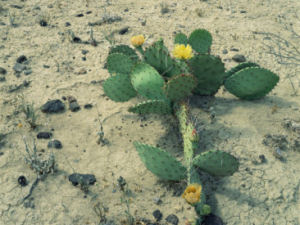
Texas State Plant: Prickly Pear Cactus
Photographs, prints, posters
The prickly pear cactus was named the official state plant of Texas by House Concurrent Resolution and is not, therefore, listed in the Texas Statutes.
Only a few of Texas' myriad symbols were actually adopted by an act of the legislature and written into the Texas Statutes.
Sources...
The State of Texas. Texas State Legislature. House Concurrent Resolution No. 44. Austin: The State of Texas, 1995. Web.
The State of Texas. Texas State Legislature. House Concurrent Resolution No. 77. Austin: The State of Texas, 1995. Web.
. "Prickly Pear Cactus." DesertUSA. Digital West Media, Inc., 2012. Web. 5 Mar 2012.
Shearer, Benjamin F. and Barbara S. State Names, Seals, Flags and Symbols: A Historical Guide Third Edition, Revised and Expanded. Westport, Conn: Greenwood Press, 3 Sub edition, 2001.
Additional Information
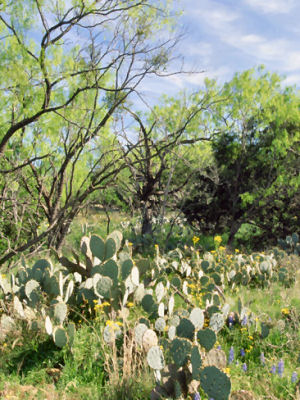
Texas State Plant: Prickly Pear Cactus
Photographs, prints, posters
Prickly Pear: DesertUSA.com.
Opuntia engelmannii var. lindheimeri: University of Texas at Austin; Lady Bird Johnson Wildflower Center; Native Plant Database.
Prickly Pear: University of Texas at Austin; Texas Beyond History; The Virtual Museum of Texas' Cultural Heritage.
More symbols & emblems: Complete list of official Texas state symbols from NETSTATE.COM.
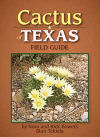
Cactus of Texas
Field Guide
Cactus of Texas Field Guide, by Nora and Rick Bowers with Stan Tekiela. 368 pages. Publisher: Adventure Publications (May 21, 2009) The Cactus of Texas Field Guide introduces readers to every species of Texas cacti. Full-page photos and detailed descriptions make this the best guide to cacti in Texas. With more photos per cactus than any other field guide, visual identification is quick and easy. Plus, readers will appreciate the shape icons, range maps and close-ups of spines, flowers and fruit, as well as fascinating natural history about each species.
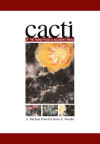
Cacti of the
Trans-Pecos and
Adjacent Areas
Cacti of the Trans-Pecos and Adjacent Areas, by A. Michael Powell and James F. Weedin. 512 pages. Publisher: Texas Tech University Press (November 15, 2004) Of the 132 species and varieties of cacti in Texas, about 104 of them occur in the fifteen counties of the Trans-Pecos region. This volume includes full descriptions of those many genera, species, and varieties of cacti, with sixty-four maps showing the distribution of each species in the region. The descriptions follow the latest findings of cactus researchers worldwide and include scientific names; common names; identifying characters based on vegetative habit, flowers, fruit, and seeds; identification of flowerless specimens; and phenology and biosystematics. The introduction—full of details about the biology and morphology of the family Cactaceae, the uses of cacti, and the horticulture and conservation of cacti—is an important reference for general readers. More than three hundred beautiful full-color photographs of the cacti in flower and in fruit, all cross-referenced to their description in the text, highlight the book. A glossary of cactus terms, an exhaustive list of literature, and a thorough index complete the book.
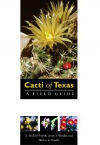
Cacti of Texas
Cacti of Texas: A Field Guide, with Emphasis on the Trans-Pecos Species, by A. Michael Powell, James F. Weedin, and Shirley A. Powell. 99 pages. Publisher: Texas Tech University Press (February 15, 2008) One hundred thirty-two species, subspecies, and varieties of cacti may be found in Texas. About one hundred of them occur in the state’s Trans-Pecos region, one of the most cactus-rich areas of the United States, but at least one kind can be found in every county of the state. This volume is an identification guide to the genera, species, and varieties of Texas cacti, with maps showing the distribution of each. Based on the comprehensive reference Cacti of the Trans-Pecos and Adjacent Regions (2004), by A. Michael Powell and James F. Weedin, this field guide provides briefer, less detailed treatments of the entire state’s species for educated general readers. More than three hundred beautiful full-color photographs of the cacti in flower and in fruit, each placed with its description in the text, highlight the book.

The Prickly Pear
Cookbook
Carolyn Niethammer
The Prickly Pear Cookbook, by Carolyn Niethammer. 99 pages. Publisher: Rio Nuevo (May 28, 2004) The Prickly Pear Cookbook gives 56 delightful recipes that are sure to impress not only your guests, but your doctor as well. The Prickly Pear cactus is delicious, nutritious and increasingly believed to be medicinal. From Prickly Pear Margaritas to recipes from internationally known chefs, such as New York's Robert Santibanez from Rosa Mexicano restaurant, Café Poca Cosa's owner and chef, Suzana Davila in Arizona, and California's Will Power from the Washington Hotel, this cookbook inspires the most inventive and tastiest creations the adventurous, and not so adventurous, cook can find.
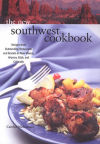
The New
Southwest Cookbook
Carolyn Niethammer
The New Southwest Cookbook: Recipes from Outstanding Restaurants and Resorts in New Mexico, Arizona, Utah, and Colorado, by Carolyn Niethammer. 256 pages. Publisher: Rio Nuevo (November 23, 2005) Recipes from outstanding restaurants and resorts in New Mexico, Arizona, Utah, and Colorado. A collection of more than 130 recipes from the Southwest's finest establishments and today's hottest chefs.

The Tex-Mex Cookbook
Robb Walsh
The Tex-Mex Cookbook: A History in Recipes and Photos, by Robb Walsh . 288 pages. Publisher: Ten Speed Press; 1 edition (June 15, 2004) Join Texas food writer Robb Walsh on a grand tour complete with larger-than-life characters, colorful yarns, rare archival photographs, and a savory assortment of crispy, crunchy Tex-Mex foods.
From the Mexican pioneers of the sixteenth century, who first brought horses and cattle to Texas, to the Spanish mission era when cumin and garlic were introduced, to the 1890s when the Chile Queens of San Antonio sold their peppery stews to gringos like O. Henry and Ambrose Bierce, and through the chili gravy, combination plates, crispy tacos, and frozen margaritas of the twentieth century, all the way to the nuevo fried oyster nachos and vegetarian chorizo of today, here is the history of Tex-Mex in more than 100 recipes and 150 photos.
Rolled, folded, and stacked enchiladas, old-fashioned puffy tacos, sizzling fajitas, truck-stop chili, frozen margaritas, Frito™ Pie, and much, much more, are all here in easy-to-follow recipes for home cooks.
The Tex-Mex Cookbook will delight chile heads, food history buffs, Mexican food fans, and anybody who has ever woken up in the middle of the night craving cheese enchiladas.

